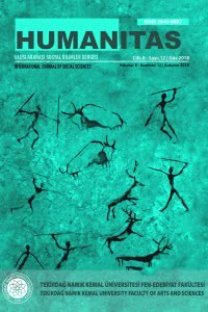Shakespeare’in Macbeth Eserinde Kutsal Kurban; Paredros
Shakespeare'in eserleri, özellikle trajedileri, bir ritüel olarak okunabilir. Arketipik bilinçdışı, antik gündönümü kültleri ve ritüel semboller açısından zengin bir kaynak sunan Shakespeare trajedilerinde bu ritüel biçimi açıkça mevcuttur. Shakespeare'in suretler çatışkısı, Ana tanrıça arketipi, cadılar ve Paredros sembollerine yaptığı vurgu, Shakespeare'in eserlerinde sanat ve ayin biçimlerin ritüel kronotopu içinde birleştirildiğini gösterir. Bu bağlamda Macbeth trajedisi, trajik kahramanın gaspçı bir kraldan kutsal bir günah keçisine dönüşmesi açısından metinsel kanıtlar oluşturmaktadır. Shakespeare karakterlerine psikanalitik yaklaşım üzerine yapılan son araştırmalara uygun olarak, Macbeth'in çocuklaştırılması ve animası ile karşılaşması, oyundaki kadınlık ilkesini bastırılmış Korkunç Anne'nin dönüşü olarak anlamamıza yol gösterecektir. Bu yazıda, Macbeth'in trajik bir kahramandan ödipal bir paredroya dönüşmesi, terimlerin eski kökenleri ile ayrıntılı olarak incelenecektir.
Anahtar Kelimeler:
grotesk, karnavalesk, Macbeth, Shakespeare, kurban
The Sacred Victim; Paredros in Shakespeare’s Macbeth
Shakespeare’s works especially his tragedies can be read as a ritual. The archetypical unconscious overtly present in Shakespearean tragedies offers a rich source of ancient solstice cults and ritual symbols. Shakespeare's emphasis on the contradiction of surrogates, the Great Mother archetype, witches and the Paredros shows that art and ritual forms are combined within the ritual chronotope in Shakespeare’s works. The tragedy of Macbeth constitutes textual evidence in terms of the tragic hero’s quest from a usurper king to a sacred scapegoat. In accordance with the recent studies on psychoanalytical approach to Shakespeare’s characters, Macbeth’s infantilization and his encounter with his anima will guide us to understand the femininity principle in the play as the return of the suppressed Terrible Mother. In this paper, Macbeth’s transfiguration from a tragic hero to an oedipal Paredros will be examined in detail with the ancient origins of the terms.
Keywords:
grotesque, carnivalesque, Macbeth, Shakespeare, Sacred,
___
- Adelman, J. (1992). Suffocating mothers. Great Britain: Routledge.
- Bakhtin, M. (1984). Rabelais and his world. (H. Iswolsky, Trans.). Bloomington: Indiana University Press. (Original work published 1965).
- Bloom, H. (1994). The western canon. San Diego: Harcourt Brace & Company.
- Brottman, M. (1993). Bakhtin and popular culture. Baltimore: The Johns Hopkins University Press.
- Calef, Victor. (1969). Lady Macbeth and infanticide or how many children had Lady Macbeth murdered? Journal of the American Psychoanalytic Association, 17(2), 528-548
- Coursen, R. H. (1967). In Deepest Consequence: Macbeth. Oxford: Oxford University Press.
- Euripides. (2013). The bacchae. (M. Griffith, Trans.). Chicago: The University of Chicago Press.
- Gasbarrone, L. (1994). The locus for the other. Minneapolis: University of Minnesota Press.
- Girard, R. (1979). Violence and the sacred. (P. Gregory, Trans.). Baltimore and London: The Johns Hopkins University Press. (Original work published 1972).
- Guberman, R. M. (1996). Julia Kristeva, interviews. New York: Columbia University Press.
- Harrison, E. J. (2020). Ancient Art and Ritual. Ankara: Gece Publishing House.
- King, E. (2019). Furious: myth, gender, and the origins of lady Macbeth. (Unpublished Master’s Thesis). The City University of New York, New York.
- Kristeva, J. (1982). Powers of horror: An essay on abjection. New York: Columbia University Press.
- Levin, J. (2002). Lady MacBeth and the Daemonologie of Hysteria. Baltimore: John Hopkins University Press.
- Lucy, N. (1997). Postmodern literary theory an anthology. Oxford: Blackwell Publishing Inc.
- Oliver, K. (1993). Reading Kristeva unraveling the double-bind. Bloomington: Indiana University Press.
- Paglia, C. (1990). Sexual personae. London and New Haven: Yale University Press.
- Shakespeare, W. (1990). Macbeth. Oxford: Oxford University Press.
- Standhartinger, A. (2012). The saturnalia in Greco-Roman culture. London: Palgrave Macmillan.
- Stockholder, K. (1990). Idea and Desire: Manichean Images of Women in Shakespeare's Plays. Baltimore: John Hopkins University Press.
- Tink, J. (2021). Horrible imaginings: Jan Kott, the grotesque, and Macbeth, Macbeth. Lodz: Lodz University Press.
- Vaught, C. J. (2016). Carnival and Literature in Early Modern England. London and New York: Routledge.
- ISSN: 2147-088X
- Yayın Aralığı: Yılda 2 Sayı
- Başlangıç: 2013
- Yayıncı: Namık Kemal Üniversitesi
Sayıdaki Diğer Makaleler
Gökçen İLHAN ILDIZ, Yakup BURAK
Şiddetsiz Direnişin Kavramsal Açmazı: Derridacı Yapısökümcü Bir Yaklaşım
Yiğit SÜMBÜL, Sengün M. ACAR-KESKİN
Acının Sosyolojisi: Afetler, Toplumsal Dayanıklılık ve Teodise Problemi
Postmodern Bir Karşı Masal “Kırmızı Başlıklı Kız Ağlıyor” Adlı Gençlik Romanında Cinsel İstismar
Eger Ṣorsalar Kim Müslimān Mısın? Başlıklı Bir İlmihâl Metni Üzerine Dil İncelemesi
Okan Celal GÜNGÖR, Beytullah BEKAR
Türlerarası Yenidenyazım: Geçmiş Zaman Elbiseleri Temelinde Söyleşim ve Ana Metinsellik
Fransızcada İlgeç Tümleci ve Dolaylı Tümlecin Biçimsel-sözdizimi Aktarması ve Yanlış Çözümlemesi
COVID-19 Salgınıyla Mücadele Politikalarının Toplumsal Cinsiyete Dayalı Yönleri
